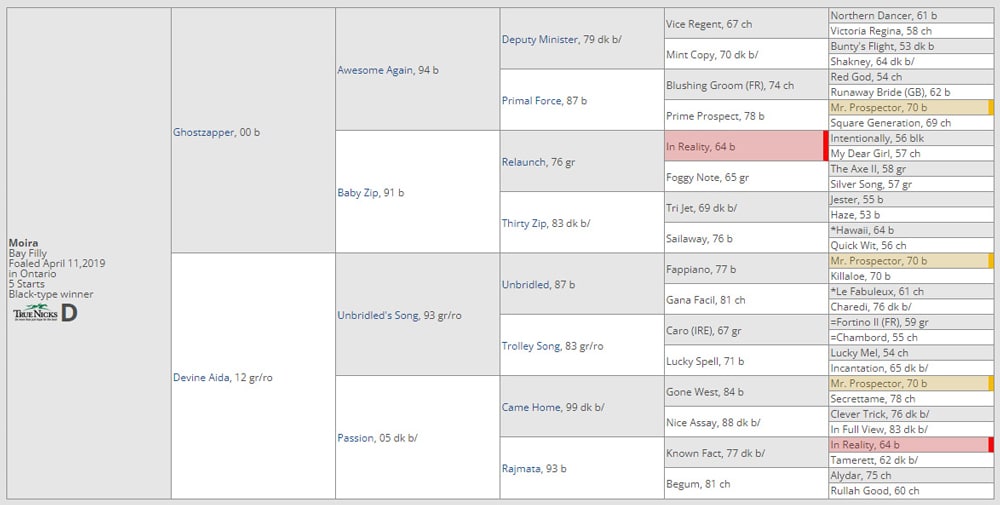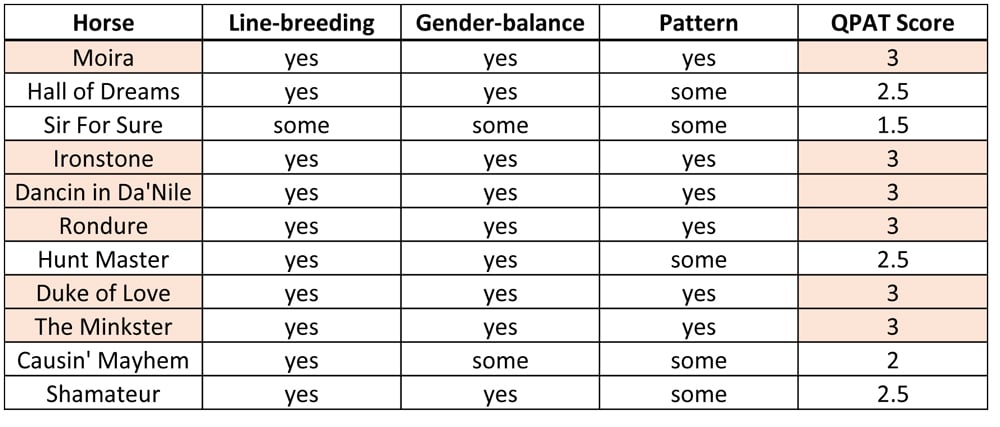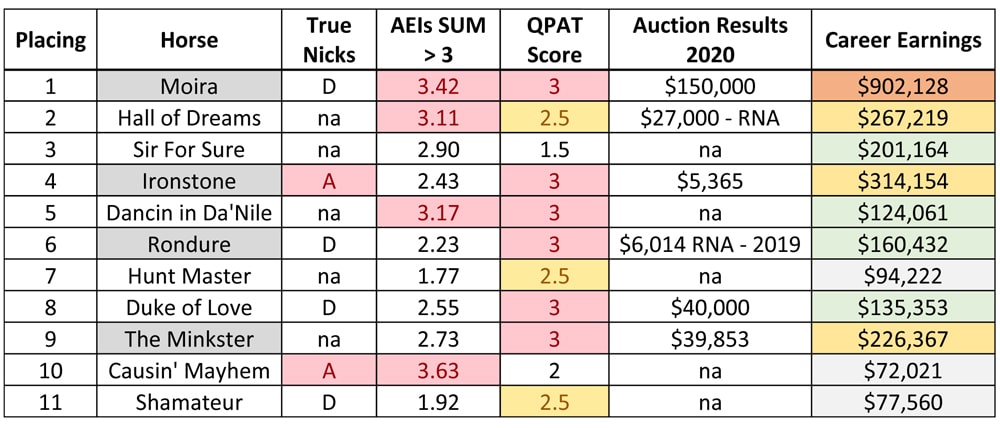On the foundation of consistent success,
luck is more likely
In the table below, the four top money earners that participated in the Queens Plate 2022 so far are Moira ($902’128), Ironstone ($314’154), Hall of Dreams ($267’219) and The Minkster ($226’367). These numbers will change, but let’s have a look at what could have identified these horses as promising prospects.
In Part I of this two-part series it was shown that the sum of the AEI of Sire and Broodmare Sire is a good identifier of racing ability. A value that is computed similarly as the “Sum of AEIs” is the TrueNicks value that can be obtained from Equineline for certain horses (if the stallion is registered on their database). “The TrueNicks rating is a score that reflects the degree of affinity between the sire and broodmare sire (or sire line and broodmare sire line) of the subject horse or hypothetical mating. […] The TrueNicks figure shows the stakes winner-to-starter production rate of the nick, compared to the stakes winner-to-starter production rate of the sire/sire line and broodmare sire/sire line when bred to representatives of all other lines.” This value again is based on statistical probability – not more and not less. It is a decent indicator if the cross has the potential of producing a stakes winner. Look for horses that are rated A or B. Only 8% of stake winners have a rating of C to F.
Reality again is, that you don’t always have those TrueNick ratings and in this field of horses, only Ironstone and Causin’ Mayhem would have fallen into the A and B rating. But again, this value is not useless at all! It’s part of the puzzle.
What is the third part of the puzzle in regards to nicking? It’s pedigree analysis. There are three major factors to look for in a pedigree: line-breeding, Filly Factor & Colt Factor and gender-balance as well as Patterns.
Line-breeding is based on the fact, that there is one (or more) ancestor that appears several times in a pedigree. This ancestor should be an outstanding individuum and ideally coming through different lines in the prospect’s pedigree. For example, it would be ideal when Mr Prospector would come through Fappiano, Forty Niner and Smart Strike instead of three times through Fappiano (or any of the other two). In the pedigree of Moira the genetics of Mr Prospector come through Fappiano, Gone West and in the sire line through the mare Prime Prospect – so through three different lines.
Filly Factor and Colt Factor takes into account if the ancestor comes through a mare or a stallion. Filly factor is considered to be a gain for both genders, while colt factor is considered to be the bigger gain for male prospects than female prospects. In this same chapter falls the concept of gender balance. If the same ancestor comes through a male and a female line it is considered genetically more powerful than only through males (colt factor) or only through females (filly factor). Staying with the pedigree of Moira as example: Mr Prospector does come on the dam side through the two stallions Fappiano and Gone West but on the sire side it is gender-balanced through the mare Prime Prospect.
Patterns tie line-breeding and gender-balance together. I introduced the theory of “Pedigree Patterns in Thoroughbreds and the Theory Behind” in 2019. It is explained why ancestors in positions that form patterns are more valuable in a pedigree than simple line-breeding. To stay with the example of Moira’s pedigree again: Mr Prospector comes through the top quarter of the pedigree and the very bottom quarter of the pedigree forming, how I call this, a top-bottom pattern. This pattern is reinforced in Moira’s pedigree through the top-bottom pattern of Mr. Prospector in her dam’s pedigree. It is further reinforced through the top-bottom pattern of her 2nd dam to Raise A Native, the sire of Mr Prospector. Patterns that are reinforced by patterns are genetically extremely powerful. Similar powerful are the inside-out patterns, where the ancestor comes through the second and third quarter of the pedigree.
(www.equineline.com)
Last but not least and with whatever system is preferred to analyse a pedigree, it is important that a pedigree is balanced. The balance in a pedigree might be a bit subjective and requires knowledge and experience. To judge a pedigree by a pedigree analysis has always something individual and reflects the analyser’s skills, knowledge, experience but also personal views.
As I think that pedigree analysis is a crucial step in the evaluation of a prospect, it should be done thoroughly. Yet, people with limited knowledge of a pedigree should be able to get some kind of a bearing with this quick and simple tool. I developed the Quick Pedigree Analysis Tool (QPAT) to break the pedigree analysis down in order to teach people how to read a pedigree. A thorough analysis goes way beyond this tool, but I found some kind of a guideline is much appreciated – especially by those who are just starting out looking at pedigrees.
Quick Pedigree Analysis (QPAT):
1) Is there line-breeding to a successful ancestor?
2) Is the line-breeding gender-balanced?
3) Is there a pattern?
For the pedigree analysis you can either use www.equineline.com or the Thoroughbred Database www.pedigreequery.com from Pedigree Online. Ideally you look at the first six generations. For an in-depth analysis I look further back (as well as for more factors) but for the above suggested quick evaluation, let’s only consider the first six generations. Please note: the QPAT is only meant to give you an idea and does not replace a proper in-depth pedigree analysis! The QPAT is calculated by replacing “yes” = 1, “some” = 0.5 and “no” = 0 and then adding the three columns.
Let’s see what scores the 2022 Queen’s Plate contenders get with the QPAT:
Now it’s time to put the puzzle together:
I looked at the pedigrees more in-depth and I really liked Moira, Ironstone, Rondure and The Minkster from the pedigree perspective: their names are greyed out in the table above. This shows that the Quick Pedigree Analysis Tool (QPAT) score gives a pretty good bearing but tends to over-estimate a pedigree.
The “diamond in the rough” in this field of horses is Ironstone. He has two of three points in the above table and one of the AEI ratings raised a flag. Considering his auction price, he was certainly an excellent option!
To conclude this article, I would like to come back to the phrase: “On the Foundation of Consistent Success, Luck is more Likely.” A good example of this is Moira: she has well-producing parents, an excellent pedigree but so far there haven’t been too many stake winners produced by the cross of her sire x broodmare sire line (TrueNicks value is D). Hence, she is an example of that lucky combination of genes that can make a successful horse an extraordinary horse.
***
Chantal Spleiss owns Rocking Wolf Ranch in Chesley, ON, and operates Magic Match Genetics, which analyzes pedigrees of Thoroughbreds and Quarter Horses.







